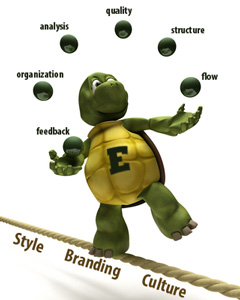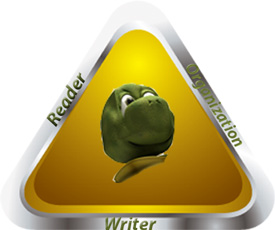Author’s Note: I am indebted to Technical Editing by Carolyn Rude and Angela Eaton for many of the ideas mentioned in this article.
 Are you a writer that works with a technical editor? If so, consider yourself fortunate; many technical writers don’t have the luxury of an editor’s services. Writers on a project team often edit each other’s documents, while writers who work alone may have no choice but to edit their own work. Though these scenarios are common, they are less than ideal.
Are you a writer that works with a technical editor? If so, consider yourself fortunate; many technical writers don’t have the luxury of an editor’s services. Writers on a project team often edit each other’s documents, while writers who work alone may have no choice but to edit their own work. Though these scenarios are common, they are less than ideal.
Writing and editing are distinct processes; each requires a different skill set and focus. Some managers don’t fully appreciate the difference between writing and editing, and what an editing specialist can bring to the table. According to Carolyn Rude and Angela Eaton, co-authors of Technical Editing, a technical editor is an expert on communication, language, and the needs of the audience.[1] A good editor has the ability to evaluate the big picture as well as the fine details and can play a key role on documentation projects.
Responsibilities of the Technical Editor
What exactly does the job of a technical editor entail? According to Rude and Eaton, there are three levels of editing:
- Comprehensive editing: reviews both content (for completeness, accuracy, and appropriate language) and form (for organization, visual design, and usability).
- Copyediting: ensures that the document is mechanically correct (spelling, punctuation, and grammar) and stylistically consistent.
- Proofreading: compares the final version of the document with the marked-up version to make sure that all corrections have been made.[2]
Other editors have suggested additional levels, such as developmental editing, which addresses document organization at the outline stage.[3] Editors don’t necessarily perform all of these levels on every project. The complexity of the edit depends on various factors, including the schedule, budget, and importance of the document.
In addition to editing, the technical editor acts as a liaison between document development and production. An editor’s duties at the production stage may include proofreading the final draft and checking that templates have been implemented. On print projects, the editor is often responsible for marking the document with instructions for typeface and layout.
The scope of a technical editor’s duties differs from one project to another depending on the client’s needs. Some editors may get involved in project management, usability testing, and the compilation of style guides. Editors’ responsibilities also vary depending on whether they are salaried employees or freelancers. Staff editors tend to be more involved with the day-to-day activities of a company and may work closely with others on a project development team.
In a nutshell, technical editors are responsible for the quality of information. This is actually a triple responsibility—to the reader, the writer, and the client or organization they work for.
Advocating for the Reader
The technical editor’s first priority is the reader; “the editor serves as the reader’s advocate.”[4] To properly serve the reader, the editor must make an effort to see the material from the reader’s point of view. The first thing an editor needs to consider is the document’s purpose—why do readers need the document, and how are they going to use it? The document’s purpose determines the level of editing to be performed and the amount of time the editor will devote to it.
Because technical documents are utilitarian in nature, users read selectively or scan to locate the information they need. To help readers find information quickly, technical editors ensure that the document’s structure reflects the hierarchy of the content (i.e., more important information should precede secondary information). Editors also verify that navigational aids such as cross-references and links are accurate and functional.
Technical editors also play a critical role in quality assurance and usability testing. To determine whether information is complete, editors should put themselves in the readers’ place and imagine the questions that readers would ask when learning something new. Editors can also help readers learn new tasks by reviewing procedures for clarity and logical flow.
Another major consideration for technical editors is audience analysis, which includes:
- Prior knowledge and experience
- Characteristics (age, reading ability, and busyness)
- Environment (equipment and software used, indoor or outdoor location)
- Cultural expectations and values (national, professional, and corporate)
We tend to think of audience analysis as the writer’s responsibility. But the technical editor also needs to take audience data into account when evaluating a document.
Regardless of the target audience, technical editors must always stay on top of several important considerations. Foremost of these is user safety; in the United States and other countries, procedures must include warnings and address regulatory requirements. Accessibility is another key area of concern. When evaluating a document’s form and content, the editor should ensure that it meets the needs of people with physical and reading disabilities. In the global marketplace, the editor must also consider localization. Editors should foresee issues that may arise in translation, such as ambiguous language or the need for extra white space, and work with the documentation team to modify the writing style and design as necessary.
Finally, while technical editors rarely have training in graphic design, they must become design-aware. They need to ensure that the visual design is audience-appropriate and doesn’t conflict with the document’s goals. Design elements include graphics, layout, typography, white space, use of color, the physical features of print documents (such as paper and binding), and audio-visual media.
Working with Writers
Technical editors and writers share a common goal: the production of clear documents that guide and educate the reader. The following tips can help editors to maintain successful working relationships with writers.
Preparation
- Try to be involved on a project from the beginning. This allows you to provide input early in the process and prevent major structural problems.
- Confirm (preferably in writing) the level of editing to be done.
- Familiarize yourself with the subject matter so that you can properly evaluate the document and avoid bothering the subject matter expert (SME) with basic questions. If the subject matter is difficult, consider scheduling a meeting with the writer or SME.
- Determine the reference sources to be used such as dictionaries and style guides.
Editing
- Avoid imposing your personal style on the writer. Don’t make a change without providing a reason such as clarity, grammar, or organization.
- Make sure that you don’t alter the writer’s meaning.
- Don’t rely solely on your instincts to decide if something is correct; double-check your assumptions by using a reference source.
- Allow enough time for the writer to review your edited version before the final deadline. Deliver long documents in sections so that the writer can deal with one chunk at a time, respond to your comments, and become comfortable with your editing style.
Communication
- Be tactful when making comments and changes. Use words with positive connotations such as “suggest” and “improve.”
- Communicate regularly with a progress report and ask questions if necessary.
- If you are working with a writer from a different cultural background, tailor your communications accordingly. For example, Asians and Europeans tend to use more formal greetings in their e-mails.
Working for Clients and Organizations
Technical editors clearly have a lot on their plates. But on top of everything else, they must also address the needs of the people that employ them. On most projects, several people get involved in document reviews (either by choice or by assignment), and the editor needs to know who to consult at each stage of the process. Before starting a new project, editors should ask, “Who’s the boss?”—or more accurately, “Who has editorial control?” It may be an executive, a manager, an SME, or even the editor herself.
Many projects operate under constraints that can have a big impact on a technical editor’s decisions. These constraints include:
- Project deadlines
- Budget and company resources such as staff and equipment
- The need to maintain compatibility with existing documents, corporate style, and usability practices
- Compliance with standards, policies, and laws
- Technical factors (such as website download time)
 Conclusion
Conclusion
A central figure in the documentation process, the technical editor has a wide range of responsibilities with respect to readers, writers, clients, and organizations. The editor advocates for the user’s point of view, collaborates with writers and SMEs, and ensures that each piece of content meets organizational objectives.
A technical editor plays a distinctive role in the content creation process and can offer many benefits to a writing team or organization. In reality, however, many writers work without the aid of an editor and assume some or all of the editor’s responsibilities. In these situations, writers need to be aware of the many considerations that editors face and understand how to maintain positive relationships with other writers.
References & Resources for the Technical Editor
Rude, Carolyn D. and Angela Eaton. Technical Editing. 5th edition. Longman, 2010.
Samuels, Jacquie. Working with a Technical Editor: Got My Edits Back, Now What? TechWhirl.com, 2012.
Technical Editing SIG (Special Interest Group), Society for Technical Communication.
Weber, Jean Hollis. Working with a Technical Editor. TechWhirl.com, 2012.
“Levels of edit.” Wikipedia. Jan. 12, 2013. http://en.wikipedia.org/wiki/Levels_of_edit.
[1] Rude, Carolyn D. and Angela Eaton, Technical Editing, 5th edition, Longman, 2010, p. 13.
[2] Ibid, p. 8-9.
[3] “Levels of edit,” Wikipedia, Jan. 12, 2013, http://en.wikipedia.org/wiki/Levels_of_edit
[4] Rude, Carolyn D. and Angela Eaton, Technical Editing, 5th edition, Longman, 2010, p. 8.